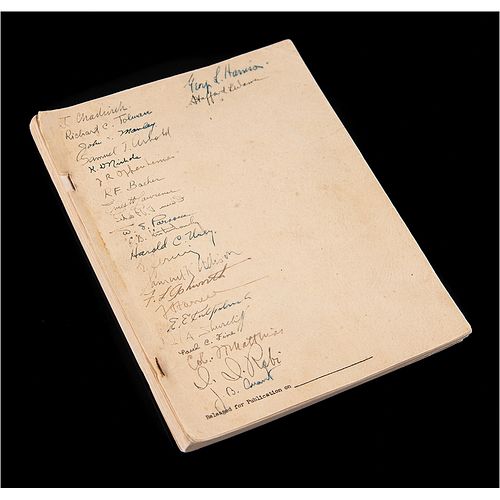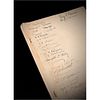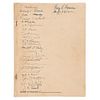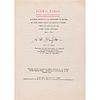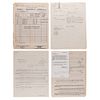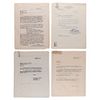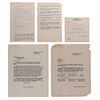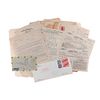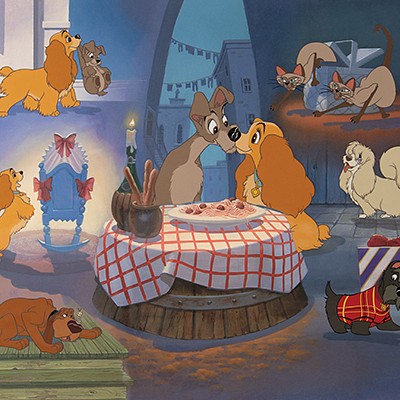Manhattan Project Atomic Bomb Report Signed by (24), with Oppenheimer, Fermi, Chadwick, and Lawrence
Two ways to bid:
- Leave a max absentee bid and the platform will bid on your behalf up to your maximum bid during the live auction.
- Bid live during the auction and your bids will be submitted real-time to the auctioneer.
Bid Increments
| Price | Bid Increment |
|---|---|
| $0 | $5 |
| $50 | $10 |
| $200 | $25 |
| $500 | $50 |
About Auction
Mar 13, 2024
RR Auction's March 2024 Fine Autographs and Artifacts auction features 650+ rare and remarkable items. The sale is highlighted by a robust selection of original animation artwork, including Eyvind Earle's remarkable landscape panoramas, Mary Blair's whimsical concept paintings, and production cels from Walt Disney classics like Snow White, Pinocchio, Lady and the Tramp, Peter Pan, and Cinderella. RR Auction support@rrauction.com
- Lot Description
Historic report on the development of the atomic bomb, entitled "Atomic Bombs: A General Account of the Development of Methods of Using Atomic Energy for Military Purposes Under the Auspices of the United States Government, 1940-1945," by Henry D. Smyth, written prior to the testing of the first bomb at the Alamogordo 'Trinity' test site, signed on the cover in ink by 24 of the most prominent scientists and administrators engaged in developing and deploying the most dangerous weapon ever created, including J. Robert Oppenheimer and Nobel Prize winners Enrico Fermi, Ernest Lawrence, James Chadwick, Harold Urey, and Isidor I. Rabi. The signatures were obtained by Gen. Leslie Groves' War Department secretary in Washington, Nellie V. Sanderson, who asked these individuals to sign the book on the occasions they came to meet with Groves.
Privately printed in August 1945, the report was written prior to the testing of the first bomb at the Alamogordo 'Trinity' test site. Smyth's preface is dated July 1, 1945, and Groves added a foreword dated August 1945. Bound in plain white heavy stock covers, the 7.75 x 10.25 report is approximately 200 pages, and contains a superb account of the technical and administrative history of the development of the atomic bomb. It is also signed on the title page in fountain pen by author Henry D. Smyth, an American physicist, diplomat, and bureaucrat who played a number of key roles in the early development of nuclear energy, as a participant in the Manhattan Project, a member of the U.S. Atomic Energy Commission (AEC), and U.S. ambassador to the International Atomic Energy Agency (IAEA). This report, called the 'Smyth Report', was first released to the press on August 12, 1945, days after the attacks on Hiroshima and Nagasaki; it is thus likely the very first publicly available report on the creation of the bomb.
Among those signing are:
Enrico Fermi (1901-1954), American physicist renowned for being the creator of the world's first nuclear reactor, the Chicago Pile-1, and a member of the Manhattan Project. He has been called the 'architect of the atomic bomb’;
J. Robert Oppenheimer (1904-1967), American theoretical physicist and director of the Manhattan Project's Los Alamos Laboratory;
Ernest O. Lawrence (1901-1958), American nuclear physicist and winner of the Nobel Prize in Physics in 1939 for his invention of the cyclotron. He is known for his work on uranium-isotope separation for the Manhattan Project, as well as for founding the Lawrence Berkeley National Laboratory and the Lawrence Livermore National Laboratory;
James Chadwick (1891-1974), English physicist awarded the 1935 Nobel Prize in Physics for his discovery of the neutron in 1932. In 1941, he wrote the final draft of the MAUD Report, which inspired the U.S. government to begin serious atom bomb research efforts. He was the head of the British team that worked on the Manhattan Project;
Harold C. Urey (1893-1981), a Nobel Prize recipient and a world expert on isotope separation, responsible for the heavy water and all the isotope enrichment processes;
Richard C. Tolman (1881-1948), American mathematical physicist and physical chemist, scientific advisor to General Leslie Groves on the Manhattan Project;
John H. Manley (1907-1990), American physicist who worked with J. Robert Oppenheimer at the University of California, Berkeley before becoming a group leader during the Manhattan Project, one of Oppenheimer's principal aides, with particular responsibility for laboratory management;
Samuel T. Arnold (1892-1956), a provost of Brown University who served Groves in procuring personnel for the Manhattan Project;
Gen. Kenneth D. Nichols (1907-2000), District Engineer of the Manhattan Engineer District. Nichols led both the uranium production facility at the Clinton Engineer Works at Oak Ridge, Tennessee, and the plutonium production facility at Hanford Engineer Works in Washington;
Robert F. Bacher (1905-2004), American nuclear physicist and one of the leaders of the Manhattan Project, head of the Experimental Physics Division and the 'Gadget Division', a key assembler of the bombs as well; Adm.
William R. Purnell (1886-1955), Navy representative on the Military Policy Committee, the three-man committee that oversaw the Manhattan Project, travelled to Tinian as the representative of the committee and coordinated preparations for the atomic bombing of Hiroshima and Nagasaki; Adm.
William S. Parsons (1901-1953), ordnance expert on the Manhattan Project, best known for being the weaponeer on the Enola Gay;
Samuel K. Allison (1900-1965), American physicist, director of the Metallurgical Laboratory from 1943 until 1944, and later worked at the Los Alamos Laboratory — where he 'rode herd' on the final stages of the project as part of the "Cowpuncher Committee", and read the countdown for the detonation of the Trinity nuclear test;
Adm. Frederick L. Ashworth (1912-2005), Navy officer employed at Los Alamos to supervise and coordinate the work of engineers in the testing at Wendover of bomb components then being developed at Los Alamos. He was also weaponeer on the B-29 'Bockscar' that dropped an atomic bomb on Nagasaki;
Gen. Thomas F. Farrell (1891-1967), Deputy Commanding General and Chief of Field Operations of the Manhattan Project, acting as executive officer to Major General Leslie R. Groves Jr.;
Col. Elmer E. Kirkpatrick (1905-1990), a special assistant to the director of the Manhattan Project, Major General Leslie R. Groves, Jr. He was sent to Tinian as liaison to the Twentieth Air Force where he was responsible for base development in support of Project Alberta and the 509th Composite Group;
William Shurcliff (1909-2006), American physicist, employed to 'locate, examine, and make secret all non-gov’t-controlled U.S. patent applications related to S-1 (the atomic bomb)'. Through October 1944, he 'put to sleep' (as he put it) at least 131 patent applications from 95 separate inventors;
Col. Franklin T. Matthias (1908-1993), American civil engineer who directed the construction of the Hanford nuclear site, a key facility of the Manhattan Project and the site of the first full-scale plutonium production reactor in the world;
Isidor I. Rabi (1898-1988), American physicist who won the Nobel Prize in Physics in 1944 for his discovery of nuclear magnetic resonance, later a consultant to the Manhattan Project. Rabi attended the Trinity test in July 1945;
James B. Conant (1893-1978), one of the most influential scientists in the Manhattan Project and a top-level government liaison;
George L. Harrison (1887-1958), Henry L. Stimson's special assistant for matters relating to the development of the atomic bomb. One of Harrison's notable moments was when he informed Secretary Stimson of the successful detonation of the atomic bomb testing in New Mexico;
Stafford L. Warren (1896-1981), American physician and radiologist best known for his invention of the mammogram. Warren was Chief of the Medical Section of the Manhattan Engineering District and was responsible for the health and safety of the thousands of personnel involved. He was present at the Trinity nuclear test in Alamogordo, New Mexico, where he was responsible for the safety aspects of the detonation.
The report is in very good to fine condition, with scattered light foxing and soiling to the partially detached cover. Accompanied by a large grouping of letters, documents, and ephemera documenting Sanderson's service with Groves and the War Department. These include her small Manhattan Project shoulder patch; Manhattan Project War Department employment documents and blank letterhead for interoffice messages, promotions, personnel documents, and much more. Also present is a business card for Leslie Richard Groves (1896-1970), U.S. Army Major General in overall command of the Manhattan Project, who also oversaw the construction of the Pentagon. - Shipping Info
-
Bidder is liable for shipping and handling and providing accurate information as to shipping or delivery locations and arranging for such. RR Auction is unable to combine purchases from other auctions or affiliates into one package for shipping purposes. Lots won will be shipped in a commercially reasonable time after payment in good funds for the merchandise and the shipping fees are received or credit extended, except when third-party shipment occurs. Bidder agrees that service and handling charges related to shipping items which are not pre-paid may be charged to a credit card on file with RR Auction. Successful international Bidders shall provide written shipping instructions, including specified Customs declarations, to RR Auction for any lots to be delivered outside of the United States. NOTE: Declaration value shall be the item’(s) hammer price and RR Auction shall use the correct harmonized code for the lot. Domestic Bidders on lots designated for third-party shipment must designate the common carrier, accept risk of loss, and prepay shipping costs.
-
- Buyer's Premium



 EUR
EUR CAD
CAD AUD
AUD GBP
GBP MXN
MXN HKD
HKD CNY
CNY MYR
MYR SEK
SEK SGD
SGD CHF
CHF THB
THB